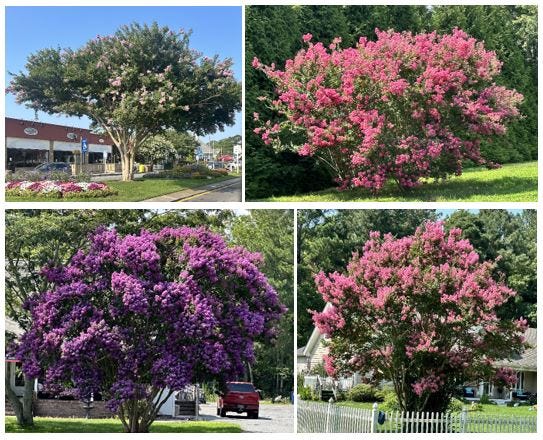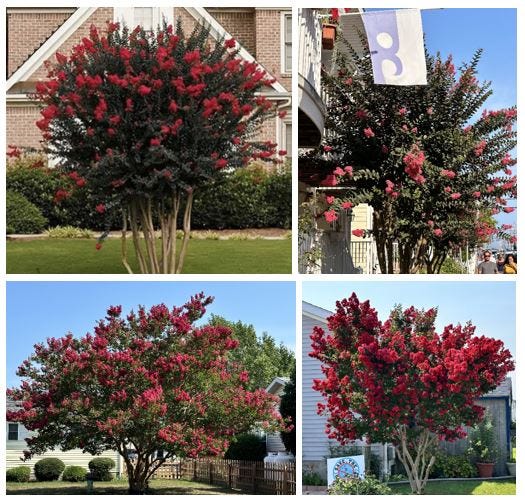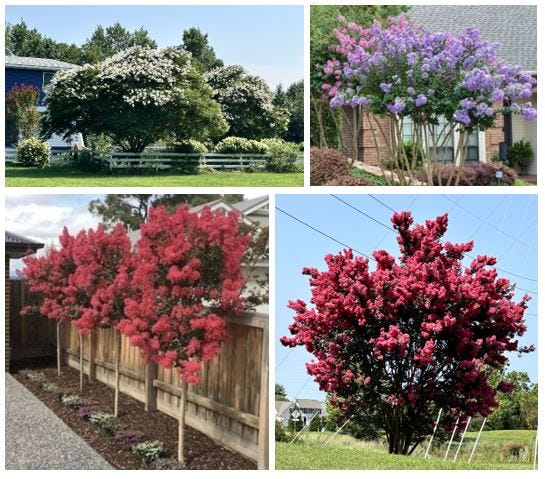Do you remember in high school there was that one girl (or boy, but keep in mind I’m a guy writing this) who was rather homely? She was smart but plain and all the boys ignored her for the blonde cheerleader? Then, at the five-year reunion, “Plain Jane” blossomed into the most beautiful woman there? And all they guys were like, “damn, where’d you come from?”
Well, here on the Delmarva Peninsula we have the same thing happening. All year we have large green expanses of foliage. Home owners and parks have green grass, bushes and trees. It’s all quite lovely if not a bit monotone. But in late July and early August magic happens. Suddenly, as if overnight, the countryside is filled with the most beautiful colors.
It’s the annual Crepe Myrtle bloom.
So many beautiful colors, white, pink, coral, red, rust, lavender, fuchsia, purple, and every shade in between.
Have you ever seen or heard of Crepe Myrtle? Well, I hadn’t until I moved to Delmarva. A hundred miles north in Pennsylvania there’s not a one. Imagine my shock when I drove down the street my first July here and saw all these amazing colors in trees and bushes that seemingly yesterday were just green.
I was surprised to learn that the Crepe Myrtle is a genus of around 50 species of deciduous and evergreen trees and shrubs native to the Indian subcontinent, southeast Asia, northern Australia, and other parts of Oceania, and that it’s been cultivated in warmer climates around the world.
The Crepe Myrtle's roots begin in China, where it was named “Pai Jih Hung,” meaning hundred days red for its beautiful color and long bloom season. The Chinese also called it the “monkey tree” because monkeys could not climb the smooth, slippery trunks. This ornamental tree was especially favored by the Tang dynasty between 618 and 906.
Crepe Myrtle was introduced into the United States around the time of its founding. In 1790 the French botanist André Michaux brought Crepe Myrtles to Charleston, South Carolina. Michaux grew these plants at his garden outside Charleston and from there they were distributed across the city. They thrived in the warm climate and became a powerful symbol of summer in the South.
For over 200 years this shrub has been bred and improved. The species grown in the U.S. blooms for a long time.
If you’re interested in planting your own, Crepe Myrtles want full sun with fertile, well drained and slightly acidic soil. Plant them in the fall or spring and you'll get quick growth. Once blooms finish, you'll get seedpods that you can leave or trim away. You can save these seeds for planting in the spring.
Of the varieties of the Crepe Myrtle in the U.S., many have been named by the National Arboretum in Washington, D.C. All the National Arboretum Crepe Myrtles are named after tribes of Native Americans, so they are easy to recognize by their names.
I drove around my community and snapped pictures of some of the most beautiful examples. I hope you enjoy them. I sure do!








The trees are also called Can’t Murder , cut them down and they grow even prettier